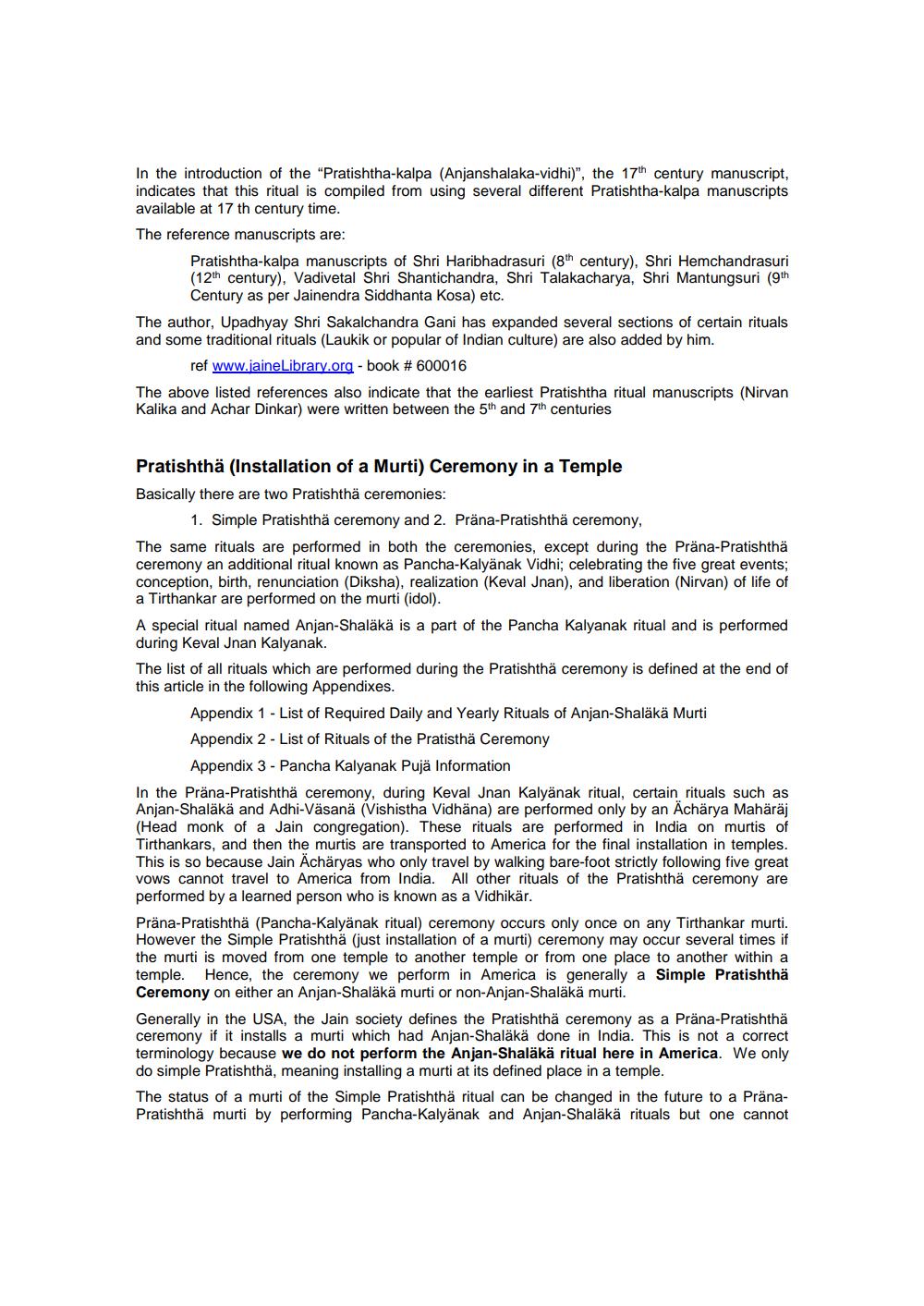Book Title: Anjan Shalaka Pran Pratistha Ceremony Shwetambar Sect Author(s): Pravin K Shah Publisher: JAINA Education Committee View full book textPage 2
________________ In the introduction of the "Pratishtha-kalpa (Anjanshalaka-vidhi)", the 17th century manuscript, indicates that this ritual is compiled from using several different Pratishtha-kalpa manuscripts available at 17 th century time. The reference manuscripts are: Pratishtha-kalpa manuscripts of Shri Haribhadrasuri (8th century), Shri Hemchandrasuri (12th century), Vadivetal Shri Shantichandra, Shri Talakacharya, Shri Mantungsuri (9th Century as per Jainendra Siddhanta Kosa) etc. The author, Upadhyay Shri Sakalchandra Gani has expanded several sections of certain rituals and some traditional rituals (Laukik or popular of Indian culture) are also added by him. ref www.jaine Library.org - book # 600016 The above listed references also indicate that the earliest Pratishtha ritual manuscripts (Nirvan Kalika and Achar Dinkar) were written between the 5th and 7th centuries Pratishthä (Installation of a Murti) Ceremony in a Temple Basically there are two Pratishthä ceremonies: 1. Simple Pratishthä ceremony and 2. Präna-Pratishthä ceremony, The same rituals are performed in both the ceremonies, except during the Präna-Pratishthä ceremony an additional ritual known as Pancha-Kalyänak Vidhi; celebrating the five great events; conception, birth, renunciation (Diksha), realization (Keval Jnan), and liberation (Nirvan) of life of a Tirthankar are performed on the murti (idol). A special ritual named Anjan-Shaläkä is a part of the Pancha Kalyanak ritual and is performed during Keval Jnan Kalyanak. The list of all rituals which are performed during the Pratishthä ceremony is defined at the end of this article in the following Appendixes. Appendix 1 - List of Required Daily and Yearly Rituals of Anjan-Shaläkä Murti Appendix 2 - List of Rituals of the Pratisthä Ceremony Appendix 3 - Pancha kalyanak Puja Information In the Präna-Pratishthä ceremony, during Keval Jnan Kalyanak ritual, certain rituals such as Anjan-Shaläkä and Adhi-Väsanä (Vishistha Vidhäna) are performed only by an Acharya Mahäräj (Head monk of a Jain congregation). These rituals are performed in India on murtis of Tirthankars, and then the murtis are transported to America for the final installation in temples. This is so because Jain Acharyas who only travel by walking bare-foot strictly following five great Vows cannot travel to America from India. All other rituals of the Pratishthä ceremony are performed by a learned person who is known as a Vidhikär. Präna-Pratishtha (Pancha-Kalyanak ritual) ceremony occurs only once on any Tirthankar murti. However the Simple Pratishthä (just installation of a murti) ceremony may occur several times if the murti is moved from one temple to another temple or from one place to another within a temple. Hence, the ceremony we perform in America is generally a Simple Pratishthä Ceremony on either an Anjan-Shaläkä murti or non-Anjan-Shaläkä murti. Generally in the USA, the Jain society defines the Pratishthä ceremony as a Präna-Pratishthä ceremony if it installs a murti which had Anjan-Shaläkä done in India. This is not a correct terminology because we do not perform the Anjan-Shaläkä ritual here in America. We only do simple Pratishthä, meaning installing a murti at its defined place in a temple. The status of a murti of the Simple Pratishthä ritual can be changed in the future to a PränaPratishthä murti by performing Pancha-Kalyanak and Anjan-Shaläkä rituals but one cannotPage Navigation
1 2 3 4
